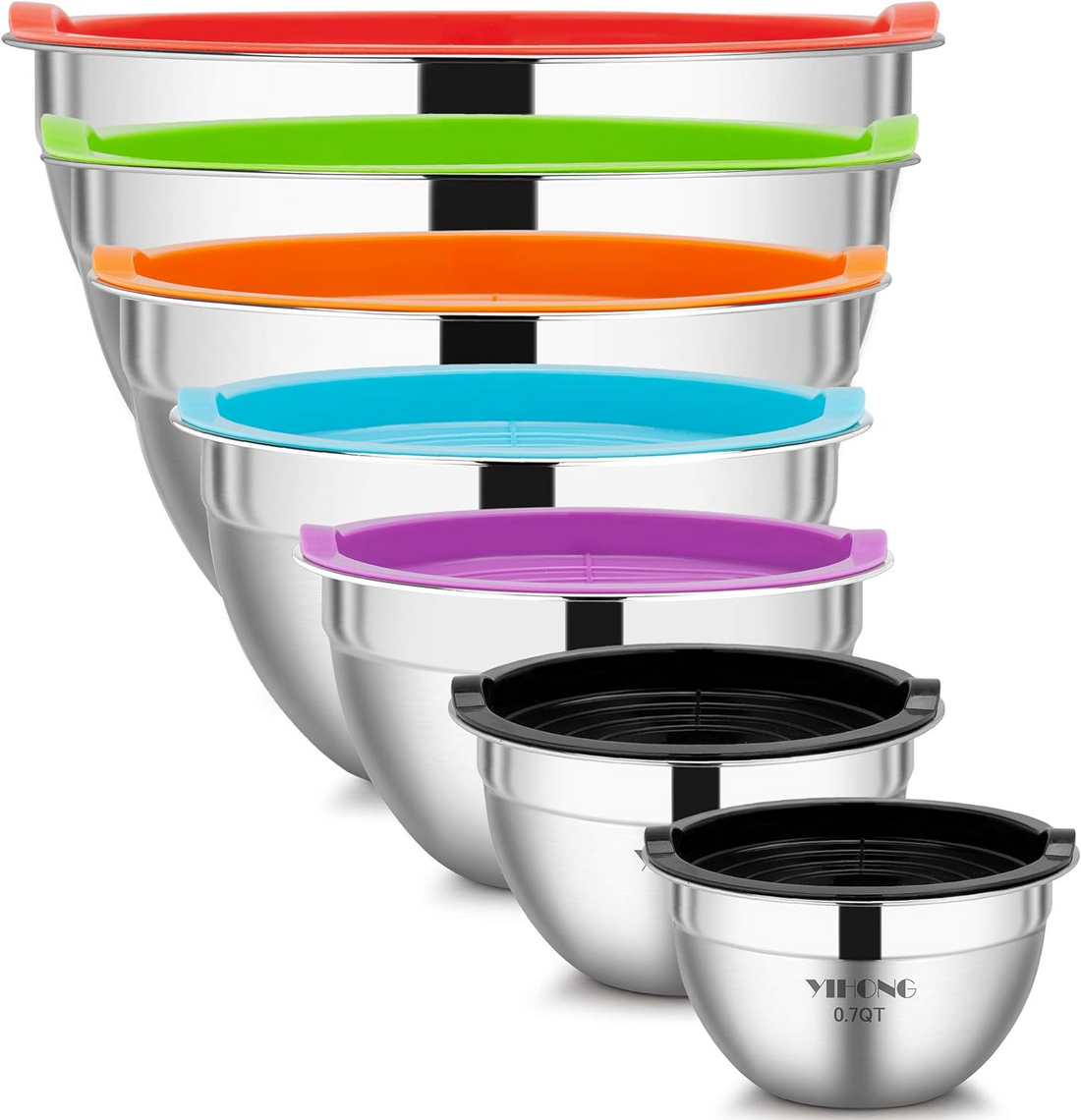The Ultimate Guide to Mixing Bowls

Share
The Ultimate Guide to Mixing Bowls: Types, Uses, and Maintenance
Mixing bowls are essential kitchen tools, used for everything from mixing ingredients to serving and storing leftovers. With so many types available, it can be overwhelming to choose the right one for your kitchen. This guide will explore the different types of mixing bowls, their uses, benefits, and maintenance tips to help you make an informed choice.
Types of Mixing Bowls
1. Stainless Steel Mixing Bowls
- Materials: High-quality stainless steel.
- Pros: Durable, lightweight, rust-resistant, non-reactive with acidic foods, dishwasher safe.
- Cons: Not microwave safe, can be slippery to hold, may dent if dropped.
- Best For: Mixing batters, whipping cream, marinating meats, and tossing salads.
2. Glass Mixing Bowls
- Materials: Tempered glass.
- Pros: Microwave safe, non-reactive, retains heat, great for serving, easy to clean.
- Cons: Heavy, can break or chip if dropped, may become hot in the microwave.
- Best For: Mixing, microwaving, and serving warm dishes.
3. Plastic Mixing Bowls
- Materials: Polyethylene, polypropylene.
- Pros: Lightweight, inexpensive, available in various colors, shatterproof, some are microwave safe.
- Cons: Can stain and retain odors, less durable, may scratch over time.
- Best For: General mixing, outdoor use, and as a budget-friendly option.
4. Ceramic Mixing Bowls
- Materials: Glazed ceramic.
- Pros: Attractive, microwave and oven safe, retains heat well, heavy and sturdy.
- Cons: Can chip or break, not ideal for whipping or fast mixing tasks.
- Best For: Serving dishes, mixing thick batters, and as decorative pieces.
5. Silicone Mixing Bowls
- Materials: Food-grade silicone.
- Pros: Flexible, non-stick, microwave and dishwasher safe, collapsible for easy storage.
- Cons: Can be too flexible for heavy mixing, less durable.
- Best For: Lightweight tasks, microwaving, and easy storage.
6. Copper Mixing Bowls
- Materials: Pure copper or copper-coated.
- Pros: Great for whipping egg whites, excellent heat conductivity, visually appealing.
- Cons: Requires polishing, not dishwasher safe, reactive with acidic foods.
- Best For: Whipping egg whites and making meringues.
Uses of Mixing Bowls
1. Mixing Ingredients
- Description: Ideal for combining ingredients for recipes like batters, doughs, and salad dressings.
- Best Bowls: Stainless steel or glass for durability and easy cleaning.
2. Marinating
- Description: Great for marinating meats, poultry, and vegetables.
- Best Bowls: Non-reactive stainless steel and glass bowls are ideal for marinating.
3. Serving
- Description: Many mixing bowls double as serving bowls for salads, side dishes, and snacks.
- Best Bowls: Ceramic and glass bowls offer aesthetic appeal for serving.
4. Microwave Cooking
- Description: Some bowls are suitable for microwaving and cooking food.
- Best Bowls: Glass and silicone bowls are microwave safe, perfect for reheating or cooking.
5. Storing Leftovers
- Description: Mixing bowls with lids can store leftovers in the refrigerator.
- Best Bowls: Plastic and glass bowls with lids are perfect for this purpose.
Choosing the Right Mixing Bowl
1. Material
- Stainless Steel: Best for general use and durability.
- Glass: Ideal for microwave use and serving.
- Plastic: Great for lightweight tasks and budget-friendly options.
- Ceramic: Perfect for serving and as decorative pieces.
- Silicone: Excellent for non-stick tasks and easy storage.
- Copper: Ideal for specialized tasks like whipping egg whites.
2. Size
- Small Bowls: Perfect for mixing small quantities or as prep bowls.
- Medium Bowls: Versatile for most mixing tasks.
- Large Bowls: Best for mixing large batches, tossing salads, or marinating.
3. Features
- Non-Slip Base: Prevents slipping during mixing.
- Pour Spout: Makes transferring batters and liquids easier.
- Lids: Convenient for storage and marinating.
Maintenance Tips for Mixing Bowls
1. Cleaning
- Stainless Steel and Glass: Dishwasher safe, but can also be hand washed with warm, soapy water.
- Plastic: Dishwasher safe, but avoid using abrasive cleaners to prevent scratches.
- Ceramic: Hand wash to prevent chipping.
- Silicone: Dishwasher safe, but hand wash with warm, soapy water if preferred.
- Copper: Hand wash and polish regularly to maintain shine.
2. Storing
- Nesting: Many mixing bowls are designed to nest within each other for easy storage.
- Lids: Bowls with lids can be stacked in the refrigerator, making storage more efficient.
3. Preventing Damage
- Avoid Abrasives: Do not use abrasive cleaners or scouring pads on any type of mixing bowl to prevent scratches and damage.
- Proper Handling: Handle glass, ceramic, and copper bowls carefully to prevent breakage or chipping.
Mixing bowls are essential kitchen tools that serve many purposes. By understanding the different types of mixing bowls, their uses, and how to maintain them, you can select the best ones for your kitchen needs. Whether you prefer the durability of stainless steel, the microwave-friendly glass, or the flexible silicone, there’s a mixing bowl that fits every requirement. With proper care, your mixing bowls will serve you for years, enhancing your cooking and baking experience.


